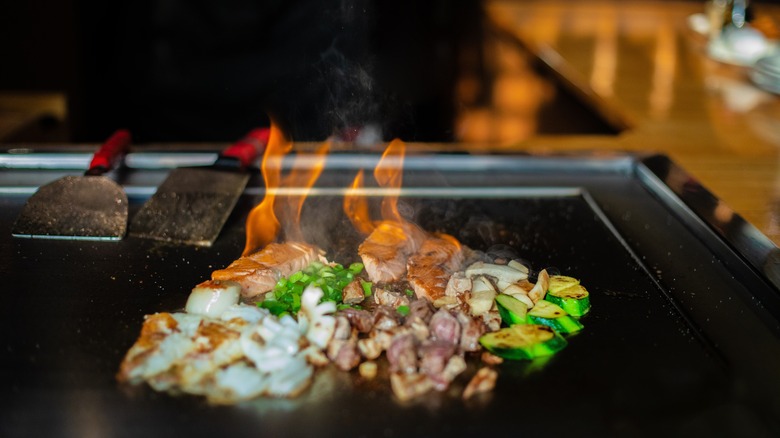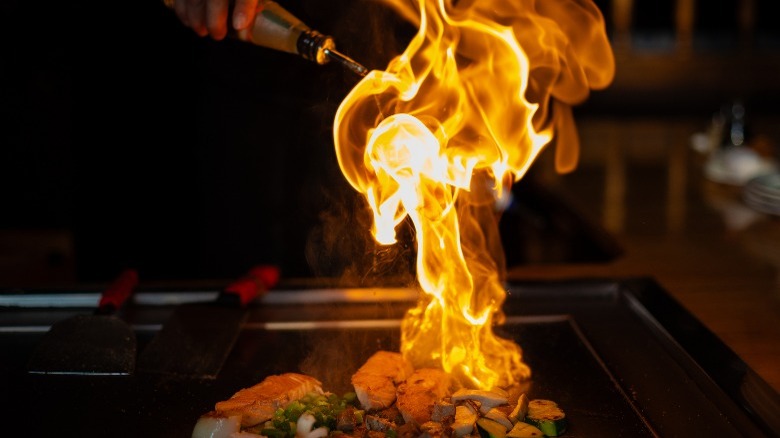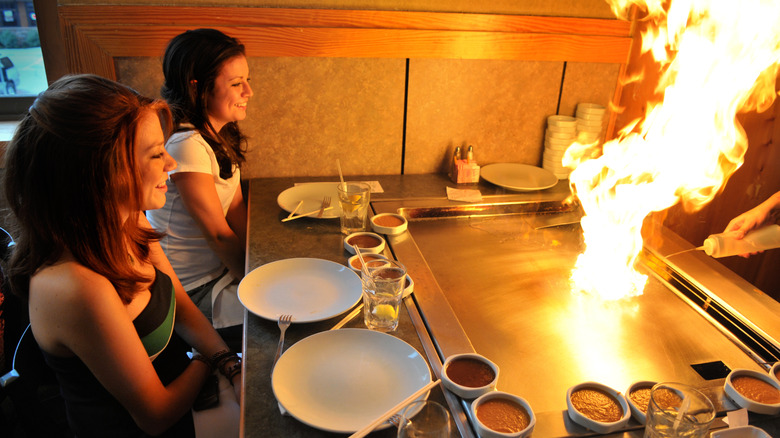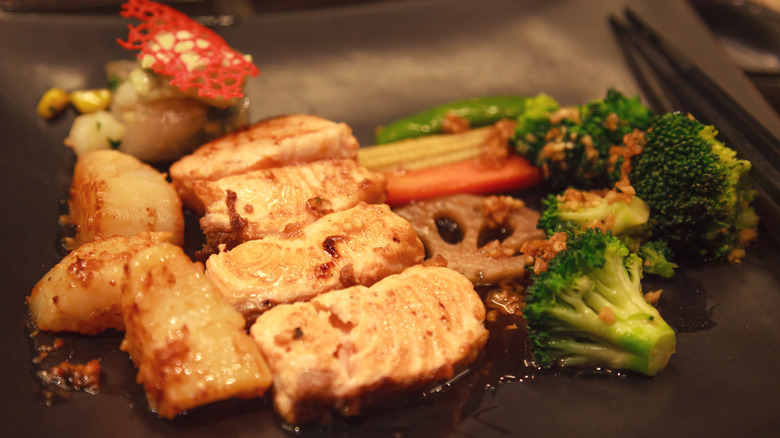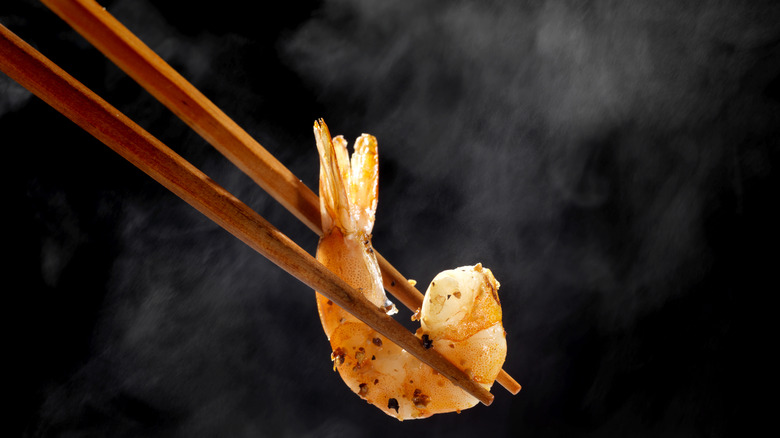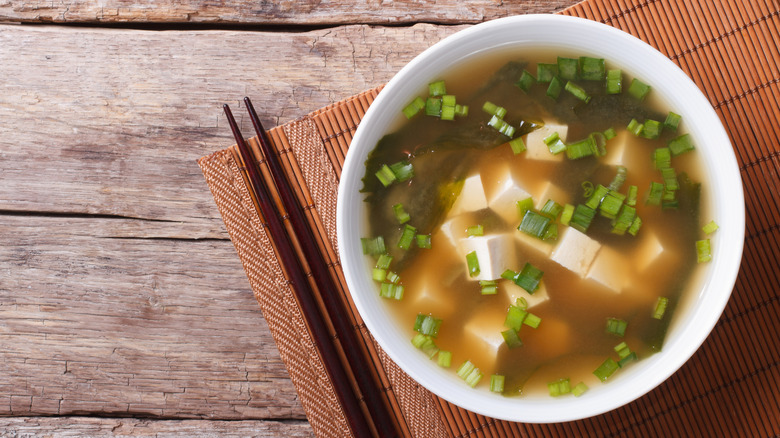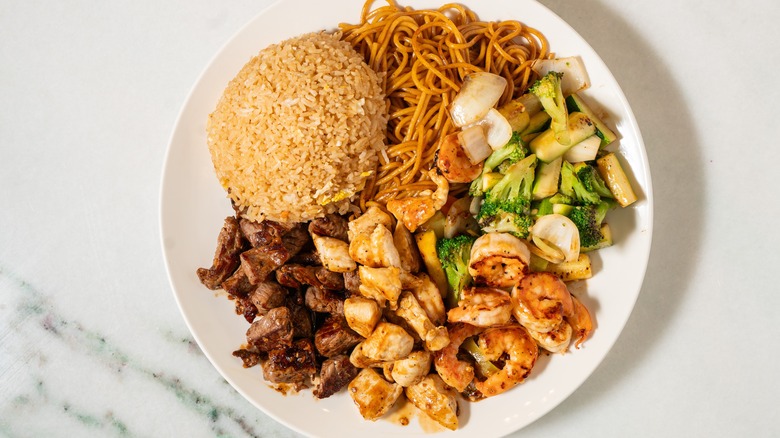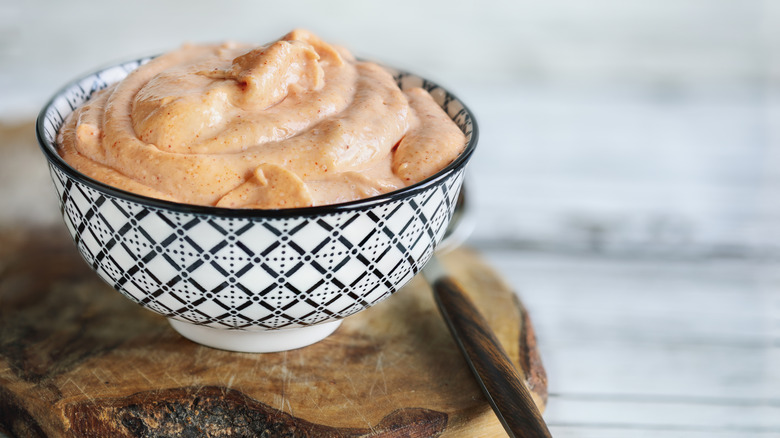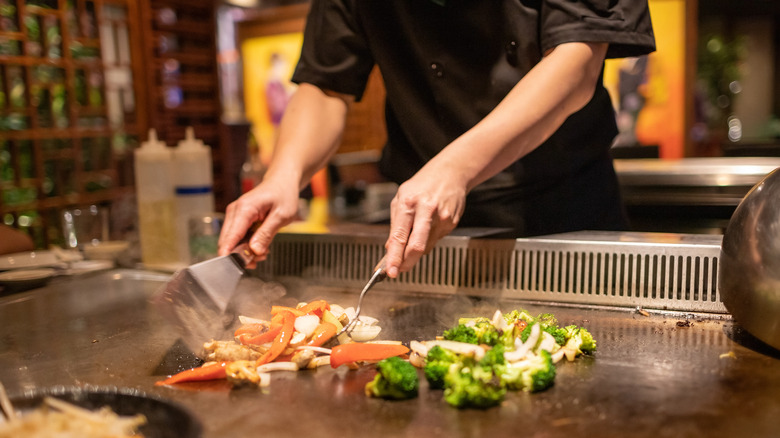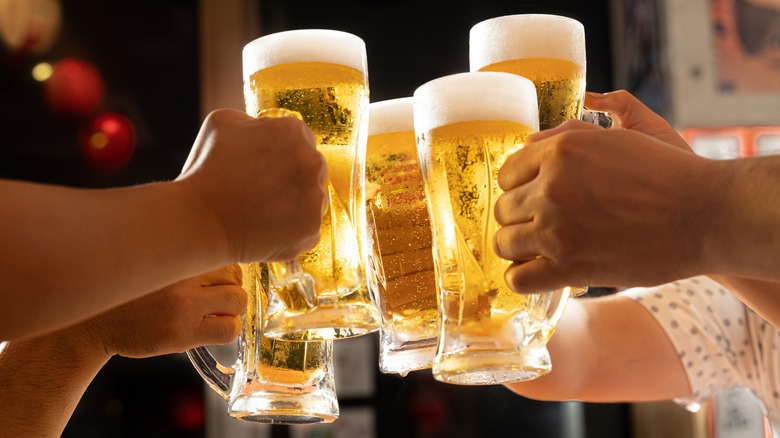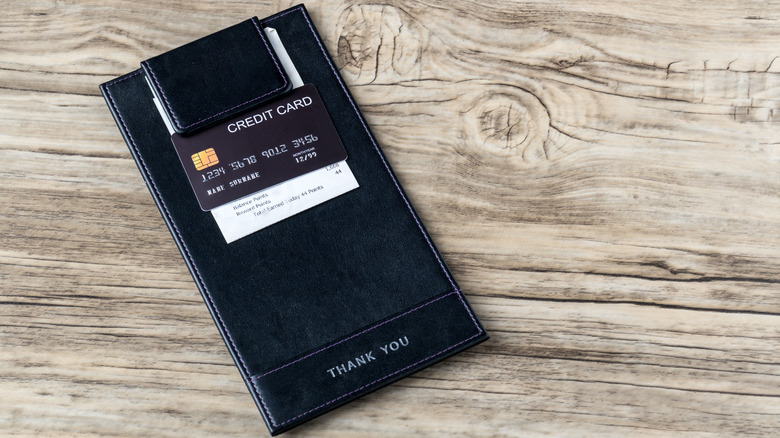11 Common Mistakes People Make At A Hibachi Restaurant
Imagine stepping into a restaurant, and immediately, all your senses awaken from a deep slumber. Not only is there the smell of tasty food, there's also the sound of cooking tools clanging and the sight of chefs showing off their culinary skills. Once you sit down, you're treated to an array of freshly grilled dishes. What we're talking about, of course, is a hibachi restaurant. Technically, in Japan, it's called a teppanyaki restaurant; "hibachi" is actually a traditional Japanese charcoal grill used to grill snacks. But after World War II, marketing for this cuisine made it so that "teppanyaki" became synonymous with "hibachi."
Today, there are hibachi restaurants all over the world. If you're near one, take advantage — it's a unique experience you shouldn't miss out on. However, there are certain dos and don'ts you should be aware of, especially if you want to have an authentic Japanese dining adventure. We've looked at several hibachi restaurants' savvy advice and drawn upon the writer's personal experiences at these establishments to give you a thorough hibachi etiquette guide. Here are the most common mistakes people make and what you should do instead.
1. Ignoring the chef's performance
One of the biggest parts of the hibachi experience is enjoying the chef's theatrics. They've spent years perfecting not only their cooking skills, but also their fun tricks — so don't ignore your chef when they're performing. It's rude to do so, and if you aren't interested in engaging with them, then you might as well eat somewhere else.
While seated at the table, admire how hibachi chefs carefully chop up ingredients, then toss them around on the grill to cook them to perfection. While they're doing so, the chefs may engage in banter with the guests, so soak it all up and get some laughs in. When beginners eat at a hibachi restaurant, they're often shocked that food is tossed directly to them. In fact, you should expect them to throw morsels like pieces of shrimp in your mouth. You can always politely decline and eat food directly from your plate, but make sure you show appreciation and applaud your chefs when they truly impress you. Be aware that chefs will toss shrimp, squirt sake, and perform a number of other exciting moves, so think twice about wearing your favorite shirt.
It's important to leave positive feedback for your hibachi chefs, but ensure that you do so at appropriate times. If they're actively cooking and are in the zone, let them concentrate until they're ready to serve you the dishes. Of course, if they indicate it's okay to do so, you can speak with the chefs prepping your food. Once they're done, let them serve you; don't reach across to grab things.
2. Failing to understand the communal dining setup
Typically, you have your own private table when you eat at a restaurant. You slide into the booths or seats, then enjoy a quiet and relaxing meal where you can converse easily with one another in a serene environment. However, this isn't the case at hibachi restaurants. You won't get private seating here; be prepared to share tables with other guests, unless you're coming with a large group of about 15 people. In that case, the restaurant will do its best to keep your group together and not split you up.
Because it's a group experience, don't expect a small space where you can easily carry on conversations. Hibachi restaurants are very lively and noisy, so you may have to repeat yourself several times in a louder-than-normal voice to convey your thoughts. You should take advantage of this opportunity and get to know the people around you. Again, it's a communal experience; the point is to share your emotions and thoughts.
3. Overlooking dietary restrictions and special requests
Classic dishes served at hibachi restaurants include shrimp tempura, and teriyaki steak, as well as hibachi chicken, scallops, calamari, shrimp, and steak. These might sound like straightforward choices, but be aware that it's typical to marinate the proteins in base sauces that have ingredients such as soy sauce, ginger, and garlic. If you have any food sensitivities or allergies, make sure you communicate your dietary needs before cooking begins to ensure you have a safe dining experience.
Many people mistakenly think that substitutions aren't allowed, but in reality, they are. In fact, you can even make special requests. Hibachi chefs will make you custom dishes, so feel free to explore your options. Specify your cooking preferences so you're not disappointed. If you're unsure of what's good, don't be afraid to ask the chef or your fellow diners. It'll certainly be something interesting to talk about, and you might even discover new favorite dishes.
4. Using chopsticks incorrectly
The beauty of American hibachi restaurants is that they offer you both forks and chopsticks to eat with. If you feel more comfortable with forks, then by all means, use one to chow down. However, if you want a more authentic time, give chopsticks a go. And we're not just talking about the main courses either; chopsticks can provide an unexpected way to eat salad, too. Don't just poke these utensils willy-nilly though, as you might inadvertently do something rude.
For example, never put chopsticks directly into your mouth. Instead, use them as a tool to pass food from your plate to your mouth. On that note, if you're sharing food with your companions, try to set aside one pair of chopsticks to use as serving utensils. Not only is this more sanitary, it's proper etiquette as well. Even though you're not in Japan, you're probably still around those with cultural or familial ties to Japan or Asia, so be mindful of chopstick taboos. Most importantly, don't pass food between pairs of chopsticks, and don't stand them in a bowl of rice vertically, as both are reminiscent of death and funeral practices.
5. Drinking miso soup with a spoon
Drinking miso soup with a spoon actually isn't a mistake, if we're being totally honest. Most (if not all) hibachi restaurants will give you a spoon, so don't feel pressured to drink without one. It'll taste the same either way, after all. But if you want to stick to the etiquette of authentic Japanese dining, leave the utensil behind.
Miso soup (not to be confused with egg drop soup, which is decidedly different) is often served as an appetizer, as it has a simple yet refreshing umami taste that segues nicely into grilled dishes. The server will bring you a small bowl, and you can drink directly from it. Simply lift it to your mouth and drink it like you would a cup of tea. Support the bowl in one hand and use chopsticks in the other to stir up the miso.
You can also use the chopsticks to eat the solid ingredients, such as tofu and seaweed. However, don't leave the bowl on the table, as it'll be difficult to transfer those ingredients to your mouth, even if you're a pro with chopsticks. You can leave the bowl lifted close to your mouth, since this minimizes the distance.
6. Not exploring the full menu
There's no doubt that at a hibachi restaurant, things made using the grill are the main stars of the menu. You're spoiled for choice with grilled chicken, shrimp, steak, and vegetables that are packed with flavor. These are filling dishes, so it's understandable that you probably won't want anything else besides miso soup to start. With each repeated visit, you stick to what you know. It's easy to get stuck in a rut.
But hibachi restaurants offer so much more than, well, hibachi. Take a look at any menu, and you'll realize that the full range of offerings is vast. There are other appetizers (also known as zensai) and sides, various types of sushi, and delicious vegetarian and vegan options even meat eaters should pay attention to. In addition, you should always ask for the seasonal and/or chef specialties to expand your palate.
On the flip side, be careful not to fill up on things like rice and noodles. These can complement the proteins wonderfully, but limit yourself to pairing only a tiny bit with each bite. You don't want to waste precious stomach space that could go to other menu options.
7. Overloading on sauces
Dipping sauces are a staple in many cuisines, and Japanese food is no exception. When you sit down at a hibachi restaurant, the servers will bring out little trays with colorful liquids and sauces within that are sure to tickle your taste buds. They can be brown, yellow, white, and pinkish, and encompass a wide range of flavors. No matter your palate, there's bound to be a sauce that's perfect for you.
One of the most popular is yum yum sauce. This condiment is a mix of mayonnaise and ketchup, as well as onion, garlic, chili, and other powders. It's sweet, yet mildly spicy and has a slight kick to it. Another common option is ginger sauce, which blends ginger, soy sauce, sake, and garlic. Feel free to experiment to find out what you like.
While these sauces are tasty, it can be easy to overdo it. As a result, you might drown out the flavors of your food. That's a major shame when the chefs have carefully marinated the proteins in a blend of explosive seasonings. Make sure you use the sauces sparingly to enhance the taste of your food, rather than overpower it. In addition, don't pour soy sauce over your rice — this will make it way too salty. Instead, use the side of rice as a way to balance out the flavors and sauces even further.
8. Waiting to eat
At a hibachi restaurant, the chef's work is never done. From the moment you arrive to the instant you leave, they constantly grill up dishes. This means that they work in a continuous fashion, and will divvy up the cooked ingredients as they go. If you wait for everyone to get their food, or if you save every bite to be had for the moment your plate's full, you'll definitely be disappointed. Your plate's contents will go stone cold, which won't be pleasant — plus, you'll have an overload of various hibachi orders, and it'll be overwhelming.
Bottom line? Don't worry about waiting for everyone else to eat when you're dining at a hibachi establishment. As soon as the chef hands you your portion of food, dig in while it's hot so you can experience hibachi at its best. Everyone else will be doing the same; no one will think you're odd or rude.
Take note, though, that some chefs might cook one dish, push it to the side, then rinse and repeat. It's an incredibly big faux pas to reach over and grab your dish on your own, as the chef is waiting until they're done with everything to serve everyone at once. So even if your hibachi steak looks tantalizing, wait for it to be served on your plate.
9. Ignoring drink pairings
The frugal think that hydrating during their meals with tap water is just fine. Those who want to really quench their thirst might go for soft drinks, which are also an acceptable choice. But to make hibachi dishes really pop, you should explore your beverage options. Ask your server for their recommended drink pairings, including cocktail suggestions that complement the foods you've ordered.
Thinking about ordering sake since you're eating Japanese food? Well, think again. It's common to see diners pair sake with sushi, but this is an American habit. The truth is, sake is made with rice, so rice on rice is redundant. The same concept applies to hibachi. It's your prerogative to sip on sake while eating hibachi shrimp and fried rice, but better choices include beer, fruit wine, and tea. If you aren't sure which will make your order shine, again, ask your server — they're the experts.
10. Rushing through the meal
This isn't fast food, so you shouldn't expect to pay the bill within 30 minutes of entering the restaurant. But hibachi is also a unique dining experience that inherently takes longer than a typical restaurant meal. You're getting dinner and a show, after all, meaning those looking to have a quick or even moderately long meal are looking in the wrong place.
You definitely don't want to shovel food in your mouth and wait impatiently for the check. But what should you do instead? The best thing is to clear out your evening schedule to dedicate enough time to the hibachi experience. Plan on having casual conversations with people around you, admiring the chefs' performance, and savoring the taste of your order. The chefs have trained hard to execute impressive tricks, and it's rude to hurry through them with no acknowledgment or appreciation; interaction is the name of the game here.
11. Forgetting to tip properly
In the United States, it's customary to leave a tip after your meal. Tipping percentages can go pretty high, depending on where you're located and how happy you are with the service. In most restaurants, you leave a tip for the wait staff, and that's it. However, you need to tip the chef separately in a hibachi restaurant, or at least account for the fact that the tip amount will be split between both the staff and the chef. In general, you should leave a tip between 10% and 15% for a hibachi chef. You should increase the amount if you're dining out during the holidays or on a special occasion.
Do note that if you dine out in Japan, there's no tipping culture at work. They've already factored in the chef's exemplary service with the menu prices, so what you see is what you get. In fact, tipping is seen as awkward or even rude, so it's best if you don't attempt it.
